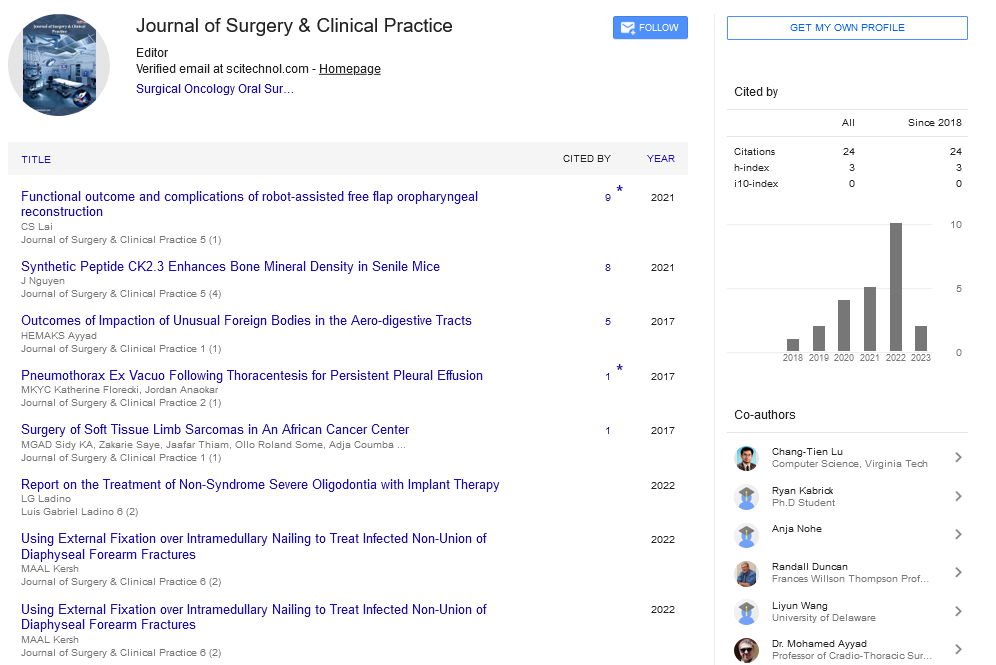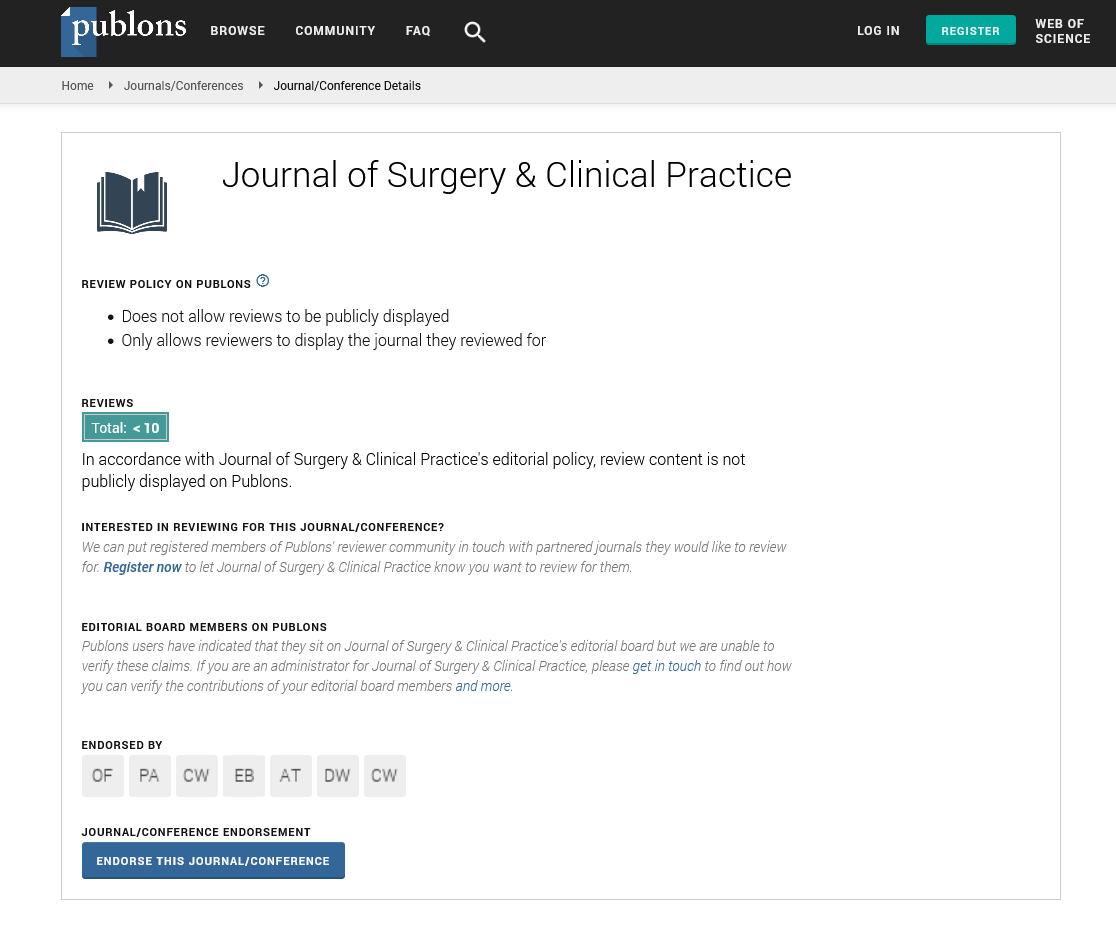Commentary, Jscp Vol: 6 Issue: 1
Optimizing Orthognathic Surgery with Virtually Planned Surgical Guides
Joao Paulo Figueiro Longo*
Department of Genetics and Morphology, Institute of Biological Sciences, Brasilia, Brazil
*Corresponding Author:
Joao Paulo Figueiro Longo
Department of Genetics and Morphology, Institute of Biological Sciences, Brasilia, Brazil
E-mail:longofigueiropaulojoao@yahoo.com
Received date: 05 January, 2022; Manuscript No. JSCP-21-56388;
Editor assigned date: 07 January, 2022; PreQC No. JSCP-21-56388 (PQ);
Reviewed date: 19 January, 2022; QC No JSCP-21-56388;
Revised date: 28 January, 2022; Manuscript No. JSCP-21-56388 (R);
Published date: 04 February, 2022; DOI: 10.4172/jscp.1000355.
Citation: Longo JPF (2022) Optimizing Orthognathic Surgery with Virtually Planned Surgical Guides. J Pls Sur Cos 6:1.
Keywords: Surgical
Introduction
The purpose of this study is to present a brief in vitro report on the development and validation of surgical guides designed digitally for orthognathic surgery. Orthognathic surgery is a procedure that was first created in the nineteenth century and has been improved ever since. The surgery's goal is to realign the jaw in order to produce optimum dental occlusion and facial symmetry. Traditionally, planning was done using a set of clinical and dental models, as well as mechanical articulators and analysis, to simulate what would be an ideal relocation of the facial skeleton. However, this process has a number of flaws, resulting in a less acceptable surgical outcome. Patients' 3D representations became available with the invention of Computer Tomography scans (CT), allowing surgeons to evaluate anatomical patterns of patients in a customized fashion. Furthermore, imaging software tools enabled clinicians to study and analyses procedures that needed to be performed in a far more precise manner than was previously possible. Due to the development of 3D printers, which allowed the production of surgical guides that allowed the execution of orthographic osteotomies at the anatomical position planned virtually because it is an accurate and quick method of manufacturing splints for orthognathic surgeries, this virtual planning was translated to surgical execution. As a result, we demonstrate a proof of concept for 3D virtual planning and maxilla repositioning in an experimental set-up with an accuracy of less than 0.53 mm for positional variations between the planned and postoperative outcomes.
Orthographic Surgery
Orthographic surgery is a surgical procedure that tries to address jaw irregularities that are either congenital or acquired. This surgical procedure entails a series of osteotomies to reposition all of the jaw's misplaced pieces in order to establish optimal static and dynamic dental occlusion as well as facial symmetry [1,2]. Aside from the apparent functional and aesthetic benefits, which have a direct impact on quality of life and self-esteem, orthognathic surgery has a wide range of benefits, including effects on speech, chewing, and grin, as well as patient respiratory measures such as oxygen saturation [3].
Since the publication of this surgical approach, planning has been carried out utilizing a collection of clinical and dental models, as well as mechanical articulators, to simulate what would be an optimal relocation of the face skeleton. Despite the technique's utility, the procedure of transferring the occlusal plane from the patient to the dental articulator contains a number of uncontrollable faults, such as plaster contraction [4,5]. Patients' 3D representations produced vital anatomical evidence for surgical applications, as well as other areas of dentistry [6,7] and medicine [8] with the introduction of Computer Tomography scans (CT). This 3D picture analysis allows doctors to assess each patient's anatomical patterns in a unique way. Apart from personal customization, 3D representations allow surgeons to engage with 3D pictures and mimic surgery, allowing them to predict postoperative soft and hard tissue outcomes [9].
This technique, known as virtual surgical planning, evolved thanks to imaging software tools. This advancement allowed doctors to explore and analyses procedures such as micrognathism, prognathism, laterognathism, maxillary atresia, and adjustments required on the frontal occlusal plane and upper dental midline in a far more precise manner than was previously possible [10]. Because it became feasible to save the virtual treatment in a viewer format, allowing discussions about the patients' treatment with orthodontists and patients themselves, this pre-evaluation allowed the surgical team to develop sensible strategies to meet the goal of orthognathic surgery. This possibility allowed for more personalised and optimised treatment for each patient's condition.
Due to the invention of 3D printers, which permitted the fabrication of surgical guides that allowed the execution of orthognathic osteotomies at the same anatomical position predicted digitally, this virtual planning was recently translated to surgical execution. Because it is a rapid, accurate, and inexpensive technique of making splints for orthognathic surgeries, surgical guides are bespoke parts that are essential to transforming virtual planning outcomes into reality. As a result, the goal of this paper is to demonstrate an in vitro proof of concept for virtual planning and surgical guide creation in order to improve the execution of orthognathic operations and patient outcomes.
Maxillary Acrylic Models
Mandibular and maxillary acrylic models (Roic, Brazil) were employed in the experimental model surgery. After coating the models surface with theopt spray cerec to enhance the scanning image captures, the virtual 3D models representation was produced by scanning them with an infrared scanner 3Shape trio's. The virtual model files were saved the files after scanning and then converted to files to continue with the virtual movements for surgical planning utilizing Computer Aided Design (CAD). The Frankfort horizontal plane was then used as a reference point for our proof of concept motions, which included three virtual planning procedures using mimics software.
The previously indicated movements were captured again using the infrared scanner, and the initial and final positions were virtually compared in order to compare the planned and conducted surgery. In order to assist result interpretation with the software 3-Matic, which automatically provides the error scale (maximum and minimum) in mm, a colored scale image contrasting the congruent and non-congruent spots of the planned and executed surgery was created. The pieces are more congruent if the color is greenish. The accuracy of the surgical guides planned and printed were evaluated using the software cloud compare, which detects changes between sequentially gathered cloud points, in our evaluation those virtually planned and those printed and scanned, ensuring that the surgical guides virtually planned could be translated to the printed acrylic surgical guides. The statistical analysis supplied by the cloud compare analysis was the Gaussian distribution, often known as the normal distribution.
Corrective jaw or orthographic surgery is a surgical treatment that corrects the bone skeleton, jaws, and face, as well as their interaction with dental occlusion, the last of which is the most significant and crucial part of orthographic surgery. Despite the fact that functional rehabilitation has a significant impact on the patients' quality of life, this surgical treatment involves a number of psychological concerns as a result of facial anatomical changes that are directly tied to this type of rehabilitation. In general, if surgery goes well, the patient's self-esteem improves. However, there is sometimes a disconnect between patient expectations and surgical outcomes. As a result, the creation of virtual 3D orthographic surgery planning was critical in bridging the gap between patient anticipation and reality. Furthermore, employing virtual planning, surgery becomes safer, more efficient, and faster.
In general, literature suggests that an accuracy of measurements for the maxilla, mandible, and chin of less than 2 mm would result in a favorable outcome between planned and postoperative positioning differences in orthographic procedures. This metric limit is altered not only by bone repositioning techniques, but also by post-operative soft tissue accommodation, which affects self-image perception in the end. This means that little mistakes made during operation planning and execution can be exacerbated throughout the recovery phase.
Virtual planning also has the advantage of saving time during the orthographic surgical operation, as practically all articles claim. The time spent for surgery is reduced because the surgeon already understands the anatomy of the patient and surgical guides fit readily. Furthermore, several writers recently calculated the time spent planning an orthographic surgery using traditional and virtual planning methodologies. In this study, scientists discovered that traditional surgical planning takes an average of 540 minutes, while virtual planning takes only 190 minutes. Surgical planning expenditures are directly proportional to the amount of time invested. Thus, virtual planning not only ensures the safety of both the patient and the surgeon, but it also takes less time, is more repeatable, and costs less than traditional planning.
As a result, we present in this report a proof of concept for 3D virtual planning and maxilla repositioning in an experimental set-up with an accuracy of 0.8 mm for positional differences between planned and postoperative outcomes, which is a significantly improved result when compared to previous studies (2 mm). In addition, we examine the potential benefits of virtual planning in improving the outcome of orthographic surgery.
Virtual planning, combined with the creation of intermediate and final position surgical guides, can increase the precision and safety of orthographic procedures, as well as other types of surgery, by reducing the risk of errors.
References
- Khadka A, Liu Y, Li J, Zhu S, Luo E, et al. (2011) Changes in quality of life after orthognathic surgery: A comparison based on the involvement of the occlusion. Oral Surg Oral Med Oral Pathol Oral Radiol Endod 112: 719-725. [Crossref],[Google Scholar],[Indexed]
- Foltán R, Hoffmannová J, PavlÃková G, Hanzelka T, KlÃma K, et al. (2011) The influence of orthognathic surgery on ventilation during sleep. Int J Oral Maxillofac Surg 40: 146-149. [Crossref],[Google Scholar],[Indexed]
- Schouman T, Rouch P, Imholz B, Fasel J, Courvoisier D, et al. (2015) Accuracy evaluation of CAD/CAM generated splints in orthognathic surgery: A cadaveric study. Head Face Med 11: 24. [Crossref],[Google Scholar],[Indexed]
- Olszewski R, Reychler H (2004) Limitations of orthognathic model surgery: Theoretical and practical implications. Rev Stomatol Chir Maxillofac 105: 165-169. [Crossref],[Google Scholar],[Indexed]
- Hsu SSP, Gateno J, Bell RB, Hirsch DL, Markiewicz MR, et al. (2013) Accuracy of a computer-aided surgical simulation protocol for orthognathic surgery: A prospective multicenter study. J Oral Maxillofac Surg 71: 128-142. [Crossref],[Google Scholar],[Indexed]
- Patel S, Durack C, Abella F, Shemesh H, Roig M, et al. (2015) Cone beam computed tomography in endodontics: A review. Int Endod J 48: 3-15. [Crossref],[Google Scholar],[Indexed]
- Sierzenski PR, Linton OW, Amis ES, Courtney DM, Larson PA, et al. (2014) Applications of justification and optimization in medical imaging: Examples of clinical guidance for computed tomography use in emergency medicine. J Am Coll Radiol 11: 36-44. [Crossref],[Google Scholar],[Indexed]
- Centenero SAH, Hernández-Alfaro F (2012) 3D planning in orthognathic surgery: CAD/CAM surgical splints and prediction of the soft and hard tissues results-our experience in 16 cases. J Craniomaxillofac Surg 40: 162-168. [Crossref],[Google Scholar],[Indexed]
- Farrell BB, Franco PB, Tucker MR (2014) Virtual surgical planning in orthognathic surgery. Oral Maxillofac Surg Clin North Am 26: 459-473. [Crossref],[Google Scholar],[Indexed]
- Swennen GR, Mollemans W, Schutyser F (2009) Three-dimensional treatment planning of orthognathic surgery in the era of virtual imaging. J Oral Maxillofac Surg 67: 2080-2092. [Crossref],[Google Scholar],[Indexed]
 Spanish
Spanish  Chinese
Chinese  Russian
Russian  German
German  French
French  Japanese
Japanese  Portuguese
Portuguese  Hindi
Hindi 
